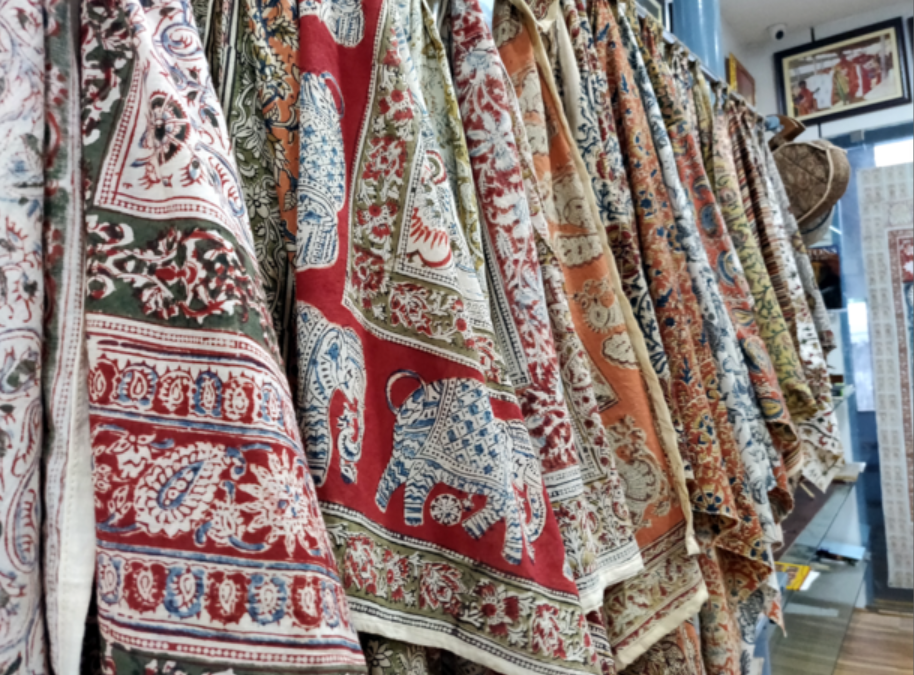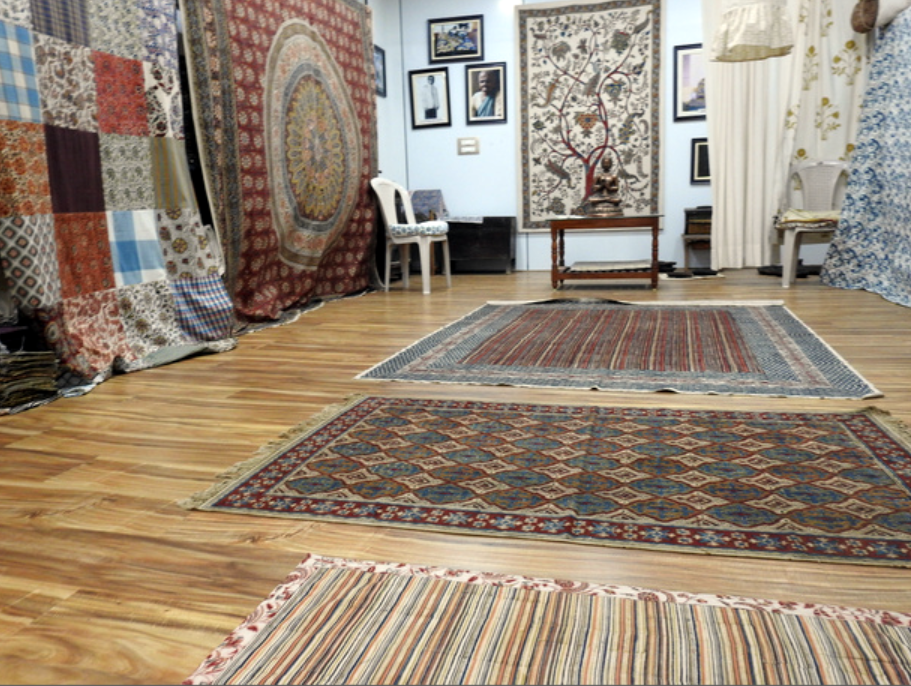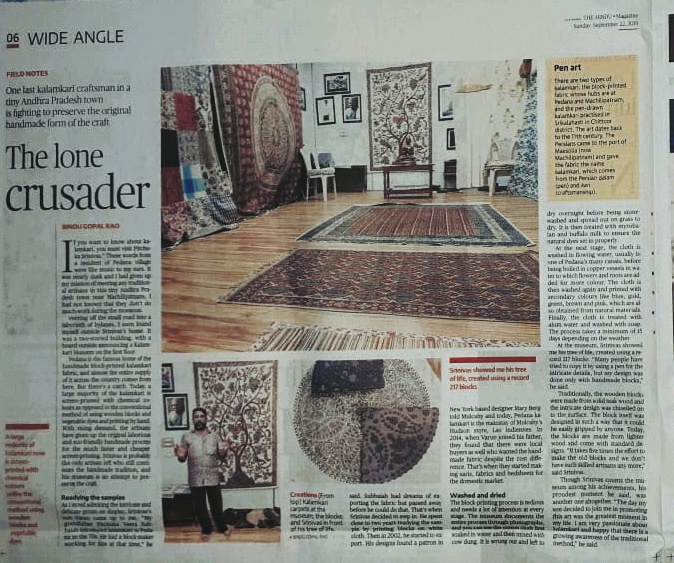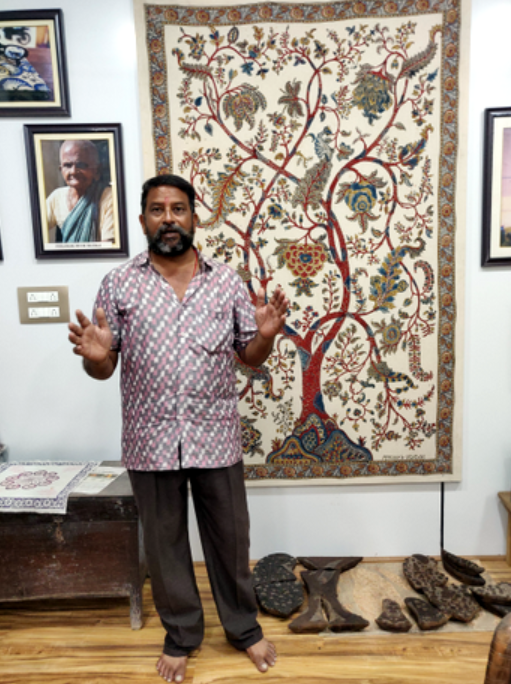Pedana, a tiny village in Andhra Pradesh is home to one of the best handloom fabrics of the region Kalamkari and there is only one craftsman who continues the traditional form of the art.
“If you want to know about Kalamkari, just visit Pitchuka Srinivas.” These words from a resident of Pedana village sounded like music to my ears. It was the nearly dusk and I had given up hope of meeting any artisan here as I found out (after I was here) that during the monsoons none of the artisans work outside. Also I had found out that a lot of the art of Kalamkari had changed into screen printed imitations. Naturally I was disappointed but when I was asked to visit Srinivas, I saw a faint glimmer of hope. Veering off the small road, into a labyrinth of small bylanes, I found myself at Srinivas’s home and soon my spirits soared as I sighted the board that I was looking for ‘Kalamkari Museum’. Located in two storied building, I made my way to the museum on the first level, where I was blown away by the sight of what I saw.
A small hall with everything to do with the fabric was on display but what caught my eye was the fact that there were traditional prints on white fabrics as opposed to the dark colours that are typical of the art. Lined on either side of the wall were all kinds of fabrics and their manifestations in cushions, bedsheets, carpets and more tools as well as a lot of photos and magazines (that I later found out were stories on Srinivas and his efforts to keep the Kalmakari tradition intact). As I am admiring at the amazing intricacy and delicate prints of the fabrics, Srinivas’s son Varun comes up to meet me. “My grandfather Pitchuka Veera Subbaiah started Kalamkari in Pedana in the 1970s and he would have a block maker working for him as well. He always had a dream to export the fabric but he passed away in 1985 without being able to fulfil his aspirations. My father then decided to pursue that dream and he saw a requirement on Indiamart that asked for samples of hand block material. He then spent close to two years to ready the sample that involved printing blocks on white material and then he started exporting the same in 2002.” His prints on white fabrics has found a patron in designer Mary Bergtold Mulcahy who has a store ‘Les Indiennes’ in Hudson in New York that has products made by Srinivas. In 2014, Varun completed his B. Tech in Electronics and decided to join his father. When he started getting calls from local buyers who wanted to buy the fabric in spite of the cost difference, they started production of saris, fabrics and bedsheets to cater to the domestic market. In fact there are two types of Kalamkari, the hand block printed versions whose hubs are at Pedana and Machilipatnam and pen-drawn Kalamkari that is practiced at Srikalahasti in Chittoor district. The art dates back to the 11th century, when the Persians came to the port of Maesolia (now Machilipatnam) and discovered the hand block fabric. The word Kalamkari itself comes from Persian qalam (meaning pen) and kari (meaning craftsmanship).

The process of making the hand block kalamkari fabrics is tedious and needs much attention at each stage. At the museum the entire process is documented through photographs so that even laymen can appreciate the efforts involved. The cotton cloth sourced from mills are soaked in water mixed with cow-dung, the water is wrung and the cloth is laid on the floor overnight and again washed on a stone in a pond and spread on grass till evening. The cloth is treated with Myrobalan seeds powder and buffalo milk that ensures the dyes are steady and colours do not run. The cloth is then printed using natural colours and washed in flowing, fresh water usually in the canals at Pedana. The cloth is then boiled in copper vessels using flowers and roots to add the colours. The cloth has to be washed again and printed with secondary colours like blue, gold, green, brown and pink which are also obtained from natural raw materials. The cloth is then treated in alum water that holds the colour and then the fabric is washed with soap. All the colours are organic and made from flowers, food materials and natural substances only. The entire process takes a minimum of 15 days based on the weather.

At the museum I was also lucky to meet Srinivas who proudly showed me his tree of life creation that has been made using a record 217 blocks. “Many people have tried to copy it but have failed as they have used the pen for the intricate details whereas this one is only made using handmade blocks. The traditional good blocks were made from solid teak wood and the design was chiseled intricately on the surface. The block itself would be designed in a way that it would be gripped easily by anyone. The modern blocks are from lighter woods and come with standard designs. It takes five times more effort to make blocks like the old one and we also don’t have skilled artisans either to make them,” says Srinivas. Stacked on one end are a whole bunch of reputed design and architecture magazines largely all foreign publications. “These have my story and also regularly feature my designs. They are kind enough to send the copies to me,” says Srinivas. And if you thought that was his biggest achievement, think again. “I feel that the day my son decided to continue working in Kalamkari is my biggest high. I am very interested that our art and craft is known by everyone,” says Srinivas. Currently he is the lone crusader who is silently fighting the battle against synthetic screen printed Kalamkari fabrics. As an artisan who is batting for the cause of the original technique of hand-block printed Kalamkari, it certainly seems that he is doing everything right to be the flag bearer for Kalamkari not just in India but across the globe.
This story first appeared in The Hindu dated 22 Sep 2019 here


Hi, I am trying to get in touch with this family. Would you have any contact details.
Yes you can get in touch with Srinivas on 9441370498
Thank you so much
Welcome Anuj.
it’s so so nice of u I got to come in contact of mr Sriniwas jee all Bz of you. I called many places to get his contact details but u know people here respond poorly.
Universe as usual helps me it’s divine intervention I learnt from u about his contact number.
Thank you very very much.
I am not that technical how is it if I have to contact u and thank personally . What’s your contact number. Regards dr uma Panjabi
9623191116
Am glad you said that! Srinivas is one of the most talented in this field and I will text you soon.
Can I buy his products online?
Yes please check
https://www.itokri.com/collections/pitchuka-srinivas-kalamkari-pedana